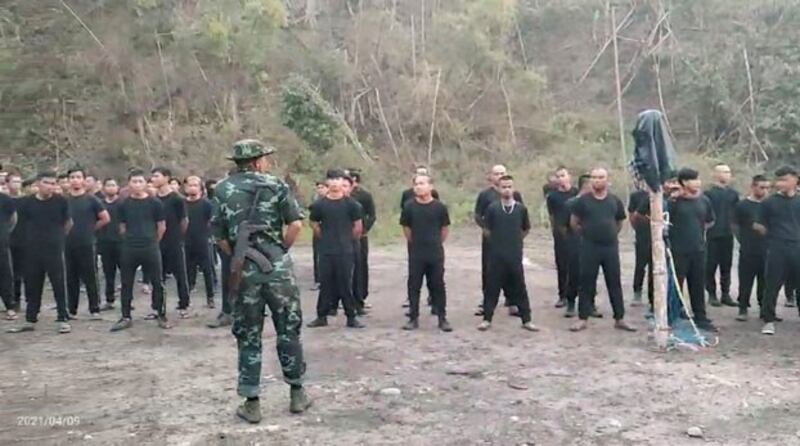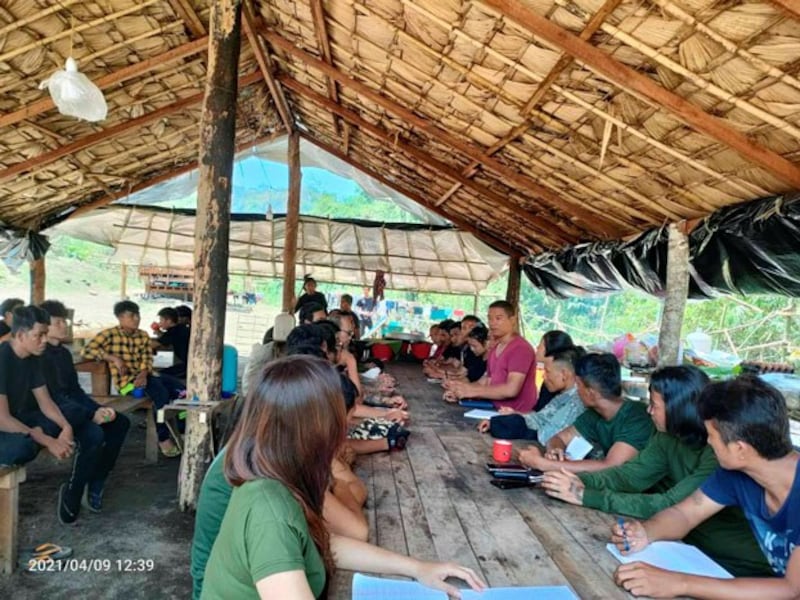Junta troops pounded a town in the mountains of western Myanmar's Chin state with heavy artillery and helicopter gunships on Sunday, killing at last five civilians in a campaign to subdue a local ethnic militia that had resisted the army with crude hunting guns, a local rights group and a media outlet said.
The weekend siege of Mindat, where the military regime had declared martial law Thursday, produced accounts of the “possible commission of war crimes” by army troops, the Chin Human Rights Organization (CHRO) said, including reports that junta soldiers were shooting civilians on sight and using them as human shields.
“At least five civilians reported dead and ten injured, and houses and properties destroyed under heavy bombings from air and ground assaults as junta army lay siege on the town of Mindat,” the CHRO said in a Facebook post Sunday.
“The Chinland Defense Force-Mindat said they made a tactical retreat in order to save civilian lives from indiscriminate attacks on the town by junta troops using heavy artillery and helicopter gunships,” the group said, referring to local militia formed last month to defend the town.
“Possible commission of war crimes may have occurred as there appears to be evidence of grave breaches of the Geneva Convention in the battle for control of Mindat town,” said the CHRO.
The Irrawaddy, an independent on-line news outlet, reported that junta troops backed by artillery and helicopters raided Mindat, a town of 20,000 people on Saturday, following several days of fighting after a ceasefire broke down on Wednesday.
The report quoted residents as saying eight Chinland resistance fighters were killed and approximately 20 were injured in shootouts in Mindat with the security forces, according to residents.
“Junta troops also used 18 detained civilians as human shields while entering the town, according to residents,” the Irrawaddy reported.
“Troops are now deployed across the town and are opening fire on anyone on the streets,” it added in a report Sunday. RFA was unable to immediately confirm the account.

‘Respect and condolences’
In a Facebook post Sunday, the Chinland Defense Force (CDF) voiced “respect and condolences to the families” of members Mang Kee Thang, Hung Awm Hung, Kee Tam, Thang Phep, Ha Khui Shing, and Khui Shing Ning, who had “donated (their) life while fighting for the public.”
Counting the six dead Chin fighters, the Thailand-based rights group Assistance Association for Political Prisoners (AAPP) said that as of Sunday, at least 796 people have been killed by the junta, and 3998 are in detention.
The attacks on civilians drew criticism from the U.S. embassy in Yangon and by rights groups.
“The military’s use of weapons of war against civilians, including this week in Mindat, is a further demonstration of the depths the regime will sink to to hold onto power. We call on the military to cease violence against civilians,” the embassy said in its Twitter account Sunday.
Phil Robertson, deputy Asia director of Human Rights Watch, said the siege of Mindat and reported abuses of local residents there comports with the Myanmar army’s “long record of wantonly disregarding human rights and failing to protect civilians in its operations.”
Thursday’s martial law declaration set the stage for the junta "to act with impunity against the people of the town, including indiscriminate attacks, disproportionate use of force, and mass roundups of suspected activists, including any men and boys who remain in the town,” he said in a statement Sunday.
Chin, a poor and mountainous state on Myanmar’s western border with Bangladesh and India, is home to about a half million mostly Christian citizens.
Mindat and the eight other townships in Chin state were among the first areas in Myanmar to form local militias to resist the junta’s security forces in response to violent crackdowns on protests against the military’s seizure of power from Aung San Suu Kyi’s democratically elected government on Feb. 1. Scores of other militias have been formed, with some receiving training from ethnic rebel armies in border areas.

‘We all have guns’
The CDF was formed on April 4, but Chin fighters had already started attacking junta forces after the March 23 arrest of anti-coup protesters when troops did not release them at a time demanded by the Chin group.
“When the deadline passed, we went to their camps and attacked them with reinforcements from Matupi,” a member of the CDF told RFA Friday.
“Every Chin man has used guns to hunt since a young age and we are all familiar with firearms. We all have guns in our houses,” said the fighter, who requested anonymity to speak freely.
“A total of 40 soldiers were killed, 30 in Mindat and 10 in Hakha,” the Chin state capital, he added.
In Chin’s neighboring Sagaing region, the city of Kalay, where more than half the population is ethnic Chin, a resistance movement called the Kalay Region Defense Association (KRDA) sprung up after the military used heavy artillery to smash barricades disperse peaceful protests in early April.
“The youth broke into small armed groups. Some groups were not strong enough to fight against the military, but now we have merged into a large organization, and we have more manpower as well as better tactics,” a KRDA member told RFA Friday, speaking on condition of anonymity for safety reasons.
He said that the youths had no experience or weapons, but were galvanized into action by the junta’s brutality. The KRDA claims to have killed nine junta soldiers in April.
“We are armed with only hunting rifles and air guns. We don’t have proper weapons, and only six out of 10 have any weapons at all,” the KRDA member said. “We only have the strength of our morals to rely on.”
Air rifles and slingshots
South of Kalay in Sagaing’s Kani township, the Kani People’s Defense Force (KPDF) sprung up after the attempted arrest of a Buddhist abbot had driven villagers into “active revolt against the military,” said a militia member, who claimed the group now has 7,000 members..
“Some of us had air rifles and others had slingshots, but I only had a knife in my hand,” he told RFA
“They had only about 60 troops that day, and when the two sides met, there were about a thousand of us. But our air rifles are no good. After firing a shot, it takes another three minutes to shoot the next,” he said.
“While our side was reloading, those armed with slingshots fired upon the enemy continuously. About 40 soldiers were killed that day,” added the KPDF fighter.
The National Unity Government (NUG), launched in mid-April by lawmakers ousted in the coup, formed a nascent national army called the People’s Defense Force (PDF) on May 5 with the goal of uniting the various local militias and forming alliances with well-armed ethnic rebel groups who have been fighting against the military for years.
“The real work for the NUG will be to bring everyone together. The groups in Chin state are very active now and their cooperation has been exemplary,” said Myanmar political analyst Than Soe Naing.
“They need to organize and help the scattered groups in the various townships and give them necessary guidance. Otherwise, the military will use a bigger force to crush the small individual resistance groups," he said.
Possibly complicating the effort, the military junta has designated the Chinland militia, the NUG and the PDF as terrorist groups.
Reported by RFA’s Myanmar Service. Translated by Khin Maung Nyane. Written in English by Paul Eckert and Eugene Whong.
